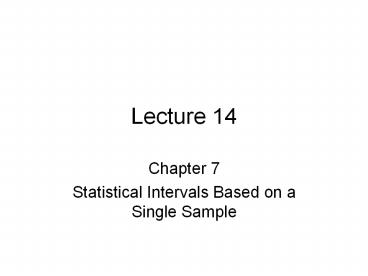Statistical Intervals Based on a Single Sample - PowerPoint PPT Presentation
1 / 13
Title:
Statistical Intervals Based on a Single Sample
Description:
The point estimate provides only a single value estimate for a population parameter. ... There are three types of continuous random variables. Nominal-the-best (NTB) ... – PowerPoint PPT presentation
Number of Views:192
Avg rating:3.0/5.0
Title: Statistical Intervals Based on a Single Sample
1
Lecture 14
- Chapter 7
- Statistical Intervals Based on a Single Sample
2
- What is a confidence interval (CI)?
- The point estimate provides only a single value
estimate for a population parameter. It does not
provide any information on how good the
estimate is, or how close it is to the real value
of the parameter. - A confidence interval provides an interval along
with a certain confidence probability value (1??)
for a population parameter. A CI indicates the
percentage of the CIs formed from a number of
different samples of same size that would contain
the real value of the estimated population
parameter. - For example
- Let the the 95 confidence interval for the mean
product length, calculated using a certain
sample, is 24,29. This means that if we kept
taking similar samples to which we calculated the
above CI from, about 95 of the CIs that we form
will contain the real value of the mean length.
Also, since (1??) 0.95, ? 0.05
3
- Types of CIs
- There are three types of CIs
- Two-sided CI ?L ? ? ? ?U
- Lower one-sided CI ?L ? ? ? ?
- Upper one-sided CI -? ? ? ? ?U
- There are three types of continuous random
variables. - Nominal-the-best (NTB) ? ?L ? ? ? ?U
- Larger-the-best (LTB) ? ?L ? ? ? ?
- Smaller-the-best (STB) ? -? ? ? ? ?U
- Most common CIs are 95, 99, and 90 CIs.
4
- Some Examples
- Nominal-the-better
- Clearance, chemical content (pH level), etc.
- We would like the value to be between two
comsumer specification limits (LSL m - ? and
USL m ?). - Larger-the-best
- Strength, lifetime, reliability, etc.
- We would like the value to be larger than a
consumer lower specification limit LSL only. - Smaller-the-better
- Amount of error, time delay, monetary loss, etc.
- We would like the value to be smaller than a
consumer upper specification limit USL only.
5
- In general, to develop a parametric CI for a
parameter ?, the sampling distribution (SMD) of
its point estimator must be known and then used
appropriately. - Further, to obtain a lower one-sided CI, the
value of ? should generally be placed at the
upper tail of a distribution and vice a versa for
an upper one-sided CI.
6
- CONFIDENCE INTERVAL FOR THE MEAN OF A NORMAL
PROCESS - WHEN THE VARIANCE IS KNOWN
7
(No Transcript)
8
(No Transcript)
9
CONFIDENCE INTERVAL FOR THE MEAN OF A NORMAL
PROCESS WHEN THE VARIANCE IS UNKNOWN
- In the previous example, the population variance
was assumed to be known. However, in reality it
is very likely that the real value of the
variance will not be known. - As the central limit theorem states, the sample
average has approximately a normal distribution,
whatever the parent distribution is, and
- However, since the value of ? is not known, we
will use the unbiased estimator S instead of ?.
The standardized variable
- follows approximately the standard normal
distribution only if n gt 40. Therefore, we will
use the standard normal distribution only if n gt
40, but not if n lt 40.
10
- For small sample sizes, or if nlt40
- The standardized variable will be denoted by T
- follows a t (Students t) distribution with
(n-1) degrees of freedom (df). The df is denoted
by ?. - The t distribution is always more spread out than
the standard normal distribution, which accounts
for the added variability due to the uncertainty
about the real value of the population variance. - For n gt 40, the t distribution becomes
practically equal to the standard normal
distribution.
11
- Confidence Interval for the Variance of a Normal
Universe
12
(No Transcript)
13
- Last topic Tolerance Intervals































